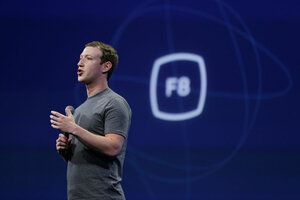Why Facebook users want more notifications
A new Notifications tab on the social networking site will include more categories such as local weather and trending events, which could be seen as an effort to stay relevant with a growing population of mobile-only users.

In this March 25, 2015 photo, CEO Mark Zuckerberg gestures while delivering the keynote address at the Facebook F8 Developer Conference in San Francisco.
Eric Risberg/AP
Facebook announced an expanded Notification tab Monday, featuring local and global updates as well as relevant information about your favorite sports teams and TV shows.
“Every day, people use their notifications to keep up-to-date with their friends and family,” product manager Keith Peiris wrote in a Facebook press release. “We’ve heard feedback that people wanted to add important information that they can easily see, all in one place.”
Instead of chronological updates on friends’ posts and interactions, Facebook showed a new feed of notifications in a promotional video that categorized updates into different categories such as “New movies this week,” “Your events today,” “TV shows on today,” and “Trending.”
By enabling Location History in the Facebook app, users can also receive notifications on local events and news, weather updates, and nearby places to eat.
This development could be a product of Facebook’s shrinking "coolness’" factor. According to a May 2015 report by Global Web Index (GWI), only 14 percent of teens vote Facebook as the "coolest" social network. Although Facebook still has the most members of any social site, it was the only major network to witness a usage drop in 2014, with a 9% decline. Facebook’s competitors Pintrest and Tumblr witnessed huge growth, at 97 and 95 percent respectively.
Facebook’s new notification features may also be a response to the recent trends of passivity among users. Namely, users are spending more time on the mobile internet and choosing to surf rather than post.
“It’s not that Facebook is being abandoned,” GWI’s head of trends Jason Mander explained in the study. “Rather, it’s that people are using Facebook less intensively or actively than before.”
And Mr. Mander suggests the increases in mobile internet and passive usage are correlated. When users browse social media on their phones, they typically are short on time and viewing smaller smartphone screens. “This encourages much more passive forms of engagement where people are more likely to simply look at things rather than interact with them,” explains Mander. Out of the 1.32 billion users Facebook reported in 2014, 30 percent of the users reported using the social networking site exclusively on their phone.
Data from Pew Research supports the passive user theory, saying users get far more than they give. According to the data, 12 percent of Facebook users tagged a friend in a photo, but 35 percent were themselves tagged and 40 percent of users in Pew’s study made a friend request, compared to 63 percent that reported receiving at least one request.
So where is all the activity coming from?
Pew suggests that “power users” skew the demographics, causing observers to underestimate the number of passive users. The average Facebook user gets more likes, friend requests, and messages than they give to others because of a segment of “power users” on the site “who specialize in different Facebook activities and contribute much more than the typical user does.”

